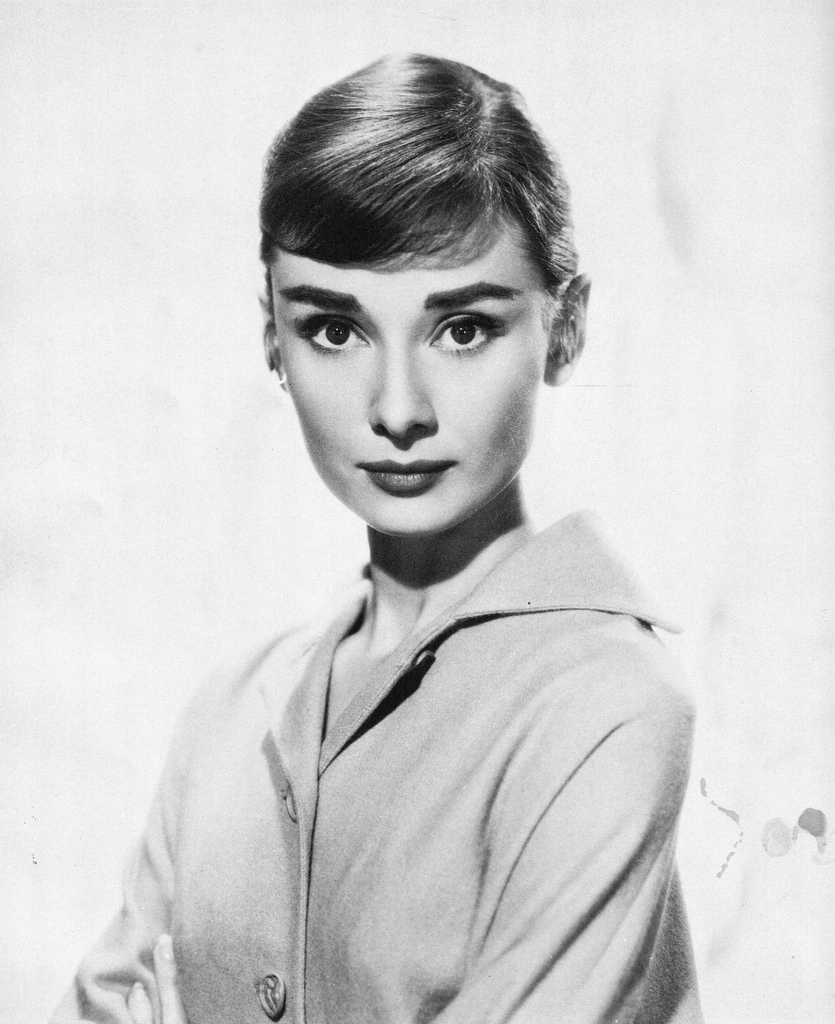Audrey Hepburn
A noted icon, Audrey Hepburn’s film career got its start in the British cinema. She began with small roles, among them as Chiquita in The Lavender Hill Mob (1951) starring Sir Alec Guinness. After being spotted by the book’s author, Colette, Hepburn then made her way to America, acquiring the lead role in the stage production of Gigi in New York. Despite being an ingenue, Hepburn was able to pull it together and turn out a performance that had The New York Times affusing, “Her quality [was] so winning and so right that she is the success of the evening.”
Soon after touring with the play, Hepburn made her screen test for Roman Holiday. Director William Wyler was captivated by the young actress and she was soon cast in her first major film, which won her an Oscar. Hepburn’s film career took off, and she made a string of successful films, among them Sabrina (1954), co-starring veteran actors Humphrey Bogart and William Holden, and War and Peace (1956). With Funny Face (1957) she put her dancing skills to work alongside Fred Astaire, and Love in the Afternoon (1957) paired her with Gary Cooper. She finished the decade with her notable portrayal of Sister Luke in the biopic The Nun’s Story (1959) which garnered her another Oscar nomination.
The ‘60’s marked a turning point in Hepburn’s career starting with her iconic role as Holly Golightly in Breakfast at Tiffany’s (1961), a fish out of water character who is trying to make her way as a modern girl in the big city. She was no longer just playing a young girl full of beauty, grace, and charm, although those qualities remained in her work. She began branching out and playing roles that stretched her abilities, including playing a blind woman in Wait Until Dark (1967). Other films from this decade included the comedic and farcical mystery Charade (1963) alongside Cary Grant and, of course, My Fair Lady (1964) where she was chosen over the musical’s original Eliza Doolittle- Julie Andrews. This film certainly cemented her box-office appeal and talent as a leading lady. For as few films as she made, she had an enormously high success rate! However, after the ‘60’s Hepburn mostly retired from acting, focusing on charity work as one of UNICEF’s most involved ambassadors.
Hepburn remains a major style icon. She made popular a slender frame and her simple, minimalistic look helped epitomized the ‘60s simplistic style, with her frequent black slacks, loafers, and sweater. She championed French fashion designer Givenchy’s designs in films, like Sabrina and Breakfast at Tiffany’s. Nevertheless, if anything, it’s her character that will always be remembered. Her love for serving others, along with those personal qualities of grace, charm, and beauty, remain in all of her film roles. These have made her an endearing icon, person, and actress
Core Films
*= my personal favorites
Roman Holiday (1953)*
Sabrina (1954)
War and Peace (1956)
Love in the Afternoon (1957)
Funny Face (1957)
The Nun’s Story (1959)*
Breakfast at Tiffanys (1961)
Charade (1963)
My Fair Lady (1964)*
How to Steal a Million (1966)
Two for the Road (1967)
For More
Books
Biography; Audrey Hepburn by Barry Paris: https://www.googleadservices.com/pagead/aclk?sa=L&ai=DChcSEwjwk7vknuThAhXGkJ8KHY79AHIYABAFGgJxYg&ohost=www.google.com&cid=CAESQeD2F13U172D7qs0aF60GZy1VEn6PV-uNsHviOpA1DppX2V1OlTYXe6OWhqXv5ofCIOE1nRHM6wrcPl5X95sh0AH&sig=AOD64_3lTNb4M5TM12TUlMH9EjqQG5bizQ&ctype=5&q=&ved=0ahUKEwivg7HknuThAhUGn-AKHRlRDVkQ5bgDCJ0B&adurl=
Biography; Enchantment: The Life of Audrey Hepburn by Donald Spoto: https://www.barnesandnoble.com/w/enchantment-donald-spoto/1100725763?ean=9780307237590&st=PLA&sid=BNB_ADL+Core+Generic+Books+-+Desktop+Medium&sourceId=PLAGoNA&dpid=tdtve346c&2sid=Google_c&gclid=CjwKCAjwzPXlBRAjEiwAj_XTEZyAZGfgOPGtDlTHQOCJ5VtMyivBP4usk_z6NIgLh1vIS3y1XSR7EBoCFMkQAvD_BwE#/























































